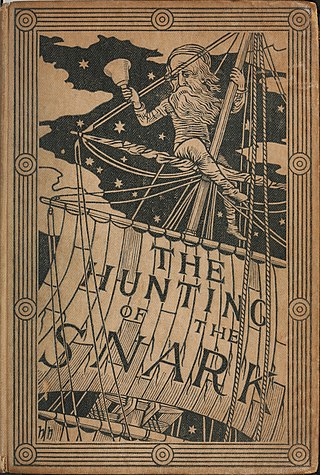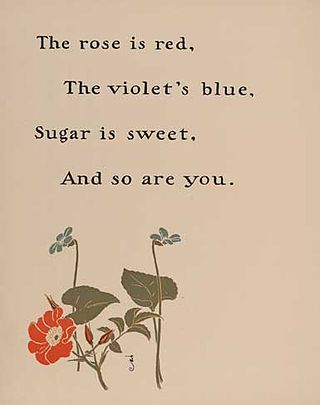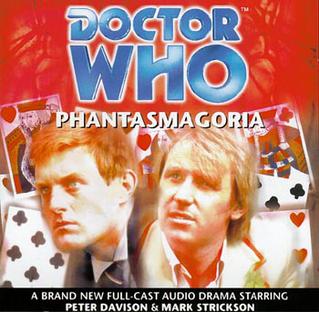
"Jabberwocky" is a nonsense poem written by Lewis Carroll about the killing of a creature named "the Jabberwock". It was included in his 1871 novel Through the Looking-Glass, the sequel to Alice's Adventures in Wonderland (1865). The book tells of Alice's adventures within the back-to-front world of the Looking-Glass world.

The Hunting of the Snark, subtitled An Agony, in Eight fits, is a poem by the English writer Lewis Carroll. It is typically categorised as a nonsense poem. Written between 1874 and 1876, it borrows the setting, some creatures, and eight portmanteau words from Carroll's earlier poem "Jabberwocky" in his children's novel Through the Looking-Glass (1871).

"The Raven" is a narrative poem by American writer Edgar Allan Poe. First published in January 1845, the poem is often noted for its musicality, stylized language and supernatural atmosphere. It tells of a distraught lover who is paid a visit by a mysterious raven that repeatedly speaks a single word. The lover, often identified as a student, is lamenting the loss of his love, Lenore. Sitting on a bust of Pallas, the raven seems to further antagonize the protagonist with its repetition of the word "Nevermore". The poem makes use of folk, mythological, religious, and classical references.

A bandersnatch is a fictional creature in Lewis Carroll's 1871 novel Through the Looking-Glass and his 1874 poem The Hunting of the Snark. Although neither work describes the appearance of a bandersnatch in great detail, in The Hunting of the Snark, it has a long neck and snapping jaws, and both works describe it as ferocious and extraordinarily fast. Through the Looking-Glass implies that bandersnatches may be found in the world behind the looking-glass, and in The Hunting of the Snark, a bandersnatch is found by a party of adventurers after crossing an ocean. Bandersnatches have appeared in various adaptations of Carroll's works; they have also been used in other authors' works and in other forms of media.
Narrative poetry is a form of poetry that tells a story, often using the voices of both a narrator and characters; the entire story is usually written in metered verse. Narrative poems do not need to rhyme. The poems that make up this genre may be short or long, and the story it relates to may be complex. It is normally dramatic, with various characters. Narrative poems include all epic poetry, and the various types of "lay", most ballads, and some idylls, as well as many poems not falling into a distinct type.

Goblin Market is a narrative poem by Christina Rossetti. It tells the story of sisters Laura and Lizzie, who are tempted with fruit by goblin merchants. In a letter to her publisher, Rossetti claimed that the poem, which is interpreted frequently as having features of remarkably sexual imagery, was not meant for children. However, in public Rossetti often stated that it was intended for children, and went on to write many children's poems. When it appeared in her first volume of poetry, Goblin Market and Other Poems, it was illustrated by her brother, the Pre-Raphaelite Brotherhood artist Dante Gabriel Rossetti.

Rusalka, Op. 114, is an opera by Antonín Dvořák. His ninth opera (1900–1901), it became his most successful, frequenting the standard repertoire worldwide. Jaroslav Kvapil wrote the libretto on Karel Jaromír Erben's and Božena Němcová's fairy tales. The rusalka is a water sprite from Slavic mythology; it usually inhabits a lake or river.

"Roses Are Red" is a love poem and children's rhyme with Roud Folk Song Index number 19798. It has become a cliché for Valentine's Day, and has spawned multiple humorous and parodic variants.

"Mugby Junction" is a set of short stories written in 1866 by Charles Dickens and collaborators Charles Collins, Amelia B. Edwards, Andrew Halliday, and Hesba Stretton. It was first published in a Christmas edition of the magazine All the Year Round. Dickens penned a majority of the issue, including the frame narrative in which "the Gentleman for Nowhere," who has spent his life cloistered in the firm Barbox Brothers & Co., makes use of his new-found freedom in retirement to explore the rail lines that connect with Mugby Junction. Dickens's collaborators each contributed an individual story to the collection.

Phantasmagoria is a Big Finish Productions audio drama based on the long-running British science fiction television series Doctor Who. The story was written by Mark Gatiss and stars Peter Davison and Mark Strickson. It was recorded between 26–27 June 1999.

In English literature, Don Juan, written from 1819 to 1824 by the English poet Lord Byron, is a satirical, epic poem that portrays the Spanish folk legend of Don Juan, not as a womaniser as historically portrayed, but as a victim easily seduced by women. As genre literature, Don Juan is an epic poem, written in ottava rima and presented in 16 cantos. Lord Byron derived the character of Don Juan from traditional Spanish folk legends; however, the story was very much his own. Upon publication in 1819, cantos I and II were widely criticised as immoral because Byron had so freely ridiculed the social subjects and public figures of his time. At his death in 1824, Lord Byron had completed 16 of 17 cantos, whilst canto XVII remained unfinished.

Phantasmagoria, alternatively fantasmagorie and/or fantasmagoria, was a form of horror theatre that used one or more magic lanterns to project frightening images – such as skeletons, demons, and ghosts – onto walls, smoke, or semi-transparent screens, typically using rear projection to keep the lantern out of sight. Mobile or portable projectors were used, allowing the projected image to move and change size on the screen, and multiple projecting devices allowed for quick switching of different images. In many shows, the use of spooky decoration, total darkness, (auto-)suggestive verbal presentation, and sound effects were also key elements. Some shows added a variety of sensory stimulation, including smells and electric shocks. Such elements as required fasting, fatigue, and drugs have been mentioned as methods of making sure spectators would be more convinced of what they saw. The shows started under the guise of actual séances in Germany in the late 18th century and gained popularity through most of Europe throughout the 19th century.

Occult detective fiction is a subgenre of detective fiction that combines the tropes of the main genre with those of supernatural, fantasy and/or horror fiction. Unlike the traditional detective who investigates murder and other common crimes, the occult detective is employed in cases involving ghosts, demons, curses, magic, vampires, undead, monsters and other supernatural elements. Some occult detectives are portrayed as being psychic or in possession of other paranormal or magical powers.

"The Signal-Man" is a horror mystery story by Charles Dickens, first published as part of the Mugby Junction collection in the 1866 Christmas edition of All the Year Round. The story is told from a fictional first-person perspective.

The Lay of the Last Minstrel (1805) is a narrative poem in six cantos with copious antiquarian notes by Walter Scott. Set in the Scottish Borders in the mid-16th century, it is represented within the work as being sung by a minstrel late in the 1600s.
The following outline is provided as an overview of and introduction to poetry:
The Hunting of the Snark is a musical based on Lewis Carroll's 1876 poem The Hunting of the Snark, written by composer Mike Batt.
Little Gidding is the fourth and final poem of T. S. Eliot's Four Quartets, a series of poems that discuss time, perspective, humanity, and salvation. It was first published in September 1942 after being delayed for over a year because of the air-raids on Great Britain during World War II and Eliot's declining health. The title refers to a small Anglican community in Little Gidding in Huntingdonshire, established by Nicholas Ferrar in the 17th century and scattered during the English Civil War.

Charles Lutwidge Dodgson, better known by his pen name Lewis Carroll, was an English author, poet, mathematician, photographer and Anglican deacon. His most notable works are Alice's Adventures in Wonderland (1865) and its sequel Through the Looking-Glass (1871). He was noted for his facility with word play, logic, and fantasy. His poems Jabberwocky (1871) and The Hunting of the Snark (1876) are classified in the genre of literary nonsense. Some of Alice's nonsensical wonderland logic reflects his published work on mathematical logic.
"The Spectre-Barber" is a short story written by Johann Karl August Musäus, included in his satirical retellings of collected folk stories, Volksmärchen der Deutschen (1786). The story was translated into French by Jean-Baptiste Benoît Eyriès as part of his collection of German ghost-stories Fantasmagoriana (1812), which inspired Mary Shelley's Frankenstein (1818) and John William Polidori's "The Vampyre" (1816). This French translation was then partially translated into English in Tales of the Dead (1813), followed by more complete translations from the original German, such as those by Thomas Roscoe (1826) and Thomas Carlyle (1827), with a child-friendly abridged version being published in 1845.














